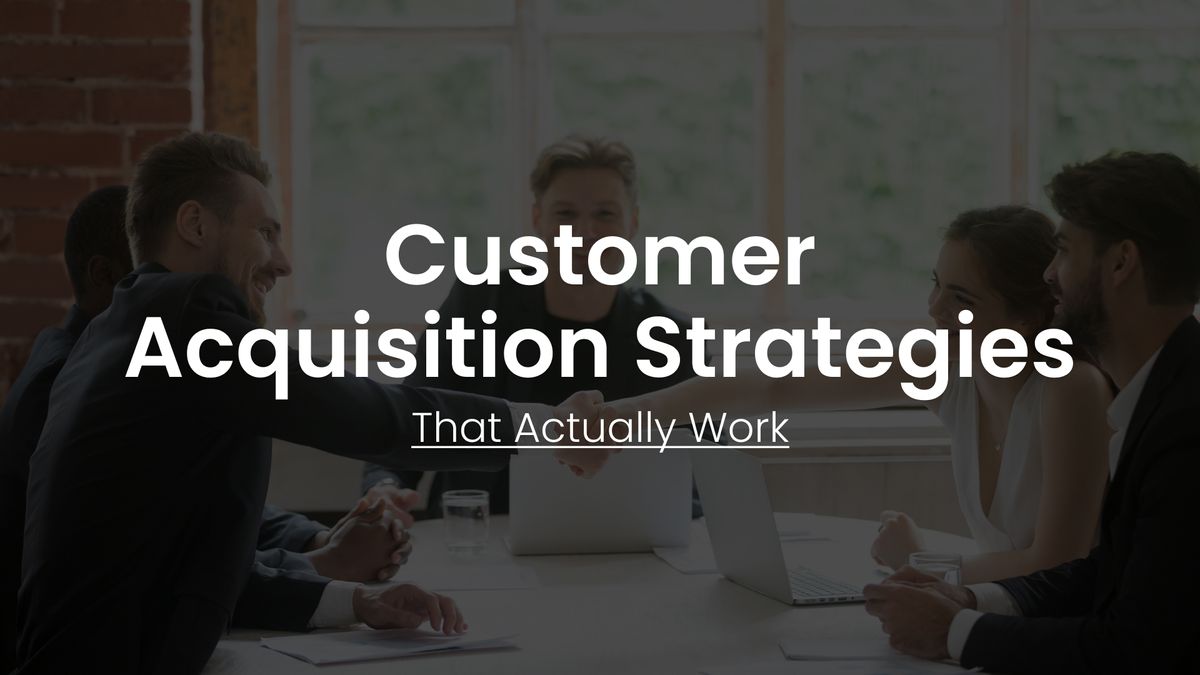10 Customer Acquisition Strategies That Actually Work

Have you ever wondered how some businesses seem to attract new customers like moths to a flame? While there's no one-size-fits-all answer to this question, there are a number of customer acquisition strategies that have been proven to work, regardless of your industry or target market.
In this blog post, we'll share 10 customer acquisition strategies that actually work. These strategies are based on real-world results and are designed to help you attract more customers, grow your business, and boost your profits.
So, whether you're a small business owner, a startup founder, or a marketing manager, read on to learn about the 10 customer acquisition strategies that you need to know.
What is Customer Acquisition Strategy?
A Customer Acquisition Strategy is a systematic plan that businesses use to acquire new customers and expand their customer base. It involves a series of tactics and techniques aimed at attracting potential customers, converting them into paying customers, and building lasting relationships.
Components of a Customer Acquisition Strategy
- Target Audience Definition: Identifying and understanding the specific demographics, behaviors, and preferences of your ideal customers.
- Marketing Channels: Selecting the most effective marketing channels (e.g., social media, email marketing, content marketing, paid advertising) to reach your target audience.
- Content Creation: Developing engaging and relevant content that resonates with potential customers and provides value.
- Lead Generation: Implementing strategies to generate leads, such as offering incentives, creating landing pages, and using lead magnets.
- Conversion Optimization: Employing techniques to convert leads into paying customers, which may involve optimizing sales funnels and checkout processes.
- Customer Relationship Management: Managing customer relationships through personalized communication, follow-ups, and nurturing to encourage repeat purchases and loyalty.
- Analytics and Measurement: Using data and analytics tools to track the performance of acquisition efforts and make data-driven improvements.
- Budget Allocation: Allocating resources and budget effectively across various acquisition channels and campaigns.
- Competitive Analysis: Studying competitors to identify opportunities and differentiate your acquisition strategies.
- Testing and Iteration: Continuously testing different strategies, messages, and approaches to refine and improve customer acquisition efforts.
10 Customer Acquisition Strategies
Certainly, here's are the most effective customer acquisition strategies:
Partnerships and Collaborations
This strategy involves forming strategic alliances with businesses that complement your own. By doing so, you can cross-promote each other's products or services to reach a broader audience. For example, a fitness equipment company might collaborate with a fitness app to promote both products simultaneously.
Landing Pages and Lead Magnets
Landing pages are dedicated web pages designed to capture visitor information, typically in exchange for valuable content or offers known as lead magnets. Lead magnets can include e-books, webinars, templates, or exclusive discounts. These pages are essential for converting website visitors into leads for future marketing efforts.
Customer Retention Strategies
Customer retention strategies are focused on keeping existing customers engaged and loyal. This involves focusing on customer retention KPIs, post-purchase communication, personalized offers, loyalty programs, and excellent customer service. Retaining customers is often more cost-effective than acquiring new ones.
Voice Search Optimization
With the rise of voice-activated devices like smart speakers and virtual assistants, optimizing your content for voice search is crucial. This includes using natural language, answering common voice queries, and ensuring that your website loads quickly and is mobile-friendly.
Interactive Content
Interactive content engages users and encourages them to actively participate. Examples include quizzes, polls, interactive infographics, and videos with decision points. Interactive content is highly shareable and can boost user engagement.
Community Building
Building an online community or forum related to your niche allows you to connect with your target audience on a deeper level. You can provide value, answer questions, and facilitate discussions. A strong community can foster brand loyalty and word-of-mouth marketing.
Subscription Models
Subscription models involve offering products or services on a recurring basis, often monthly or annually. Customers subscribe to access these offerings regularly. This strategy provides predictable revenue, enhances customer retention, and encourages loyalty. For example, streaming services like Netflix and software subscriptions like Microsoft 365 use this model.
Augmented Reality (AR) Marketing
AR marketing incorporates augmented reality technology to create immersive and interactive experiences for customers. For instance, retail brands can use AR to enable customers to try on clothing virtually or visualize how furniture would look in their homes. These engaging experiences can enhance brand engagement and drive conversions.
AI-Powered Personalization
AI-driven personalization uses machine learning algorithms to tailor content, recommendations, and product suggestions to individual customer preferences. For example, e-commerce websites may use AI to recommend products based on a customer's browsing and purchase history. Personalized experiences can improve customer engagement metrics and conversion rates by providing relevant content and offerings.
5 Ecommerce customer acquisition strategies
Here are five effective customer acquisition strategies tailored specifically for e-commerce businesses:
Search Engine Optimization (SEO)
Optimize your e-commerce website for search engines to improve its visibility in organic search results. This includes optimizing product descriptions, using relevant keywords, and ensuring your site is mobile-friendly. Appearing higher in search rankings can drive organic traffic and attract potential customers actively searching for products.
Paid Advertising (PPC)
Implement Pay-Per-Click (PPC) advertising campaigns through platforms like Google Ads and Bing Ads. This allows you to display targeted ads to users searching for specific keywords or products. PPC can drive immediate traffic and conversions, making it a valuable strategy for e-commerce businesses.
Social Media Advertising
Leverage social media advertising on platforms like Facebook, Instagram, and Pinterest to showcase your products to a wide audience. These platforms offer advanced targeting options based on demographics, interests, and behaviors, helping you reach potential customers interested in your products.
Content Marketing and Blogging:
Create high-quality blog content that addresses common questions, problems, or interests related to your products. Content marketing not only improves your website's SEO but also establishes your brand as an authority in your niche. Informative and engaging content can attract and retain potential customers.
Email Marketing and Abandoned Cart Recovery
Build and segment your email list to deliver personalized content, promotions, and product recommendations to subscribers. Implement abandoned cart recovery emails to remind users of products left in their carts and encourage them to complete their purchase. Email marketing is a powerful tool for nurturing leads and turning them into customers.
Customer Acquisition Funnel
The customer acquisition funnel, often referred to as the sales funnel, is a visual representation of the customer journey of potential customers go through before making a purchase. It is divided into several stages, each representing a different phase of the customer's decision-making process. Here are the typical stages of a customer acquisition funnel:
- Awareness: This is the top of the funnel (TOFU). At this stage, potential customers become aware of your brand, product, or service. They may have encountered your brand through advertising, social media, content marketing, or word-of-mouth.
- Interest: In this stage, potential customers show interest in what you offer. They might explore your website, read blog posts, watch videos, or engage with your social media content. The goal is to capture their attention and keep them engaged.
- Consideration: At the consideration stage, prospects are evaluating their options. They might compare your product or service with competitors, read reviews, or sign up for email newsletters. This is a critical phase where you need to provide valuable information to help them make an informed decision.
- Intent: When prospects reach the intent stage, they are seriously considering making a purchase. They may add items to their cart, request quotes, or initiate the checkout process. This is a high-potential stage for conversion.
- Conversion: This is the moment when prospects become paying customers. They complete the purchase, and you acquire a new customer. It's essential to make this process as smooth and frictionless as possible.
- Retention: Customer acquisition doesn't end with the sale. In fact, retaining existing customers is often more cost-effective than acquiring new ones. At the retention stage, you work to keep customers satisfied, engaged, and loyal. You may offer post-purchase support, loyalty programs, or upsell/cross-sell opportunities.
- Advocacy: Satisfied customers can become brand advocates. They recommend your products or services to others, write positive reviews, and spread the word. Advocacy can help attract new potential customers, starting the cycle over again.
Customer Acquisition Metrics
Customer acquisition metrics are used to measure the effectiveness of a company's customer acquisition efforts. These metrics can help companies to identify which channels and strategies are most effective at attracting and converting new customers.
Here are some of the most important customer acquisition metrics:
- Customer acquisition cost (CAC): CAC is the average cost of acquiring a new customer. It is calculated by dividing the total cost of customer acquisition by the number of new customers acquired during a specific period of time.
- Customer lifetime value (CLTV): CLTV is the total revenue that a customer is expected to generate over the course of their relationship with a company. It is calculated by multiplying the average customer lifetime by the average customer purchase value.
- Churn rate: Churn rate is the percentage of customers who stop doing business with a company during a specific period of time. It is calculated by dividing the number of customers who churn by the total number of customers at the beginning of the period.
- Conversion rate: Conversion rate is the percentage of visitors to a website or landing page who take a desired action, such as signing up for a newsletter or making a purchase. It is calculated by dividing the number of conversions by the total number of visitors.
- Cost per lead (CPL): CPL is the average cost of generating a new lead. It is calculated by dividing the total cost of lead generation by the number of leads generated during a specific period of time.
How an GPT powered AI chatbot can help acquire more customers?
GPT-powered AI chatbots like Manifest AI can help businesses acquire more customers in a number of ways:
- 24/7 customer support: A chatbot can provide 24/7 customer support, which can be especially helpful for businesses that operate in multiple time zones. This can help to increase customer satisfaction and reduce response times.
- Lead generation: A chatbot can be used to generate leads by qualifying potential customers and collecting their contact information. This can save businesses time and resources that would otherwise be spent on manually qualifying leads.
- Personalized marketing: A chatbot can be used to deliver personalized marketing messages to potential customers. This can be done by segmenting the customer base and targeting different messages to each segment.
- Abandoned cart recovery: A chatbot can be used to remind customers about abandoned carts and encourage them to complete their purchases. This can help to increase sales and reduce cart abandonment rates.
Conclusion
Now that you know 10 customer acquisition strategies that actually work, it's time to put them into practice! Choose the strategies that are most relevant to your business and your target audience, and start implementing them today.
Don't expect to see results overnight. It takes time and effort to build a strong customer base. But if you're consistent with your customer acquisition efforts, you'll start to see results over time.
Remember, customer acquisition is an ongoing process. As your business grows and changes, you may need to adjust your strategies accordingly.

.png)
